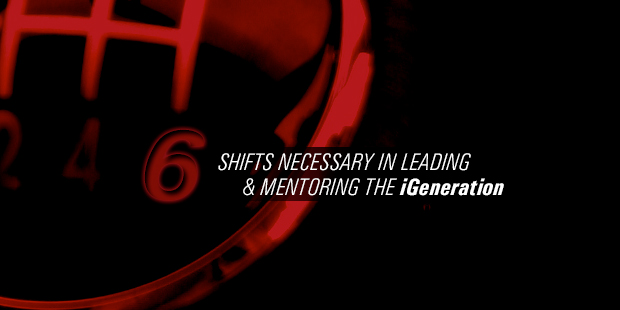Have you been keeping up with demographics? Almost half the world’s population is 25 and under. That’s about three billion young people. If we’re really serious about reaching the world, we must get serious about understanding and connecting with these kids. Just three years ago in America, Generation Y reached a milestone. (They are the youth born between 1984 and 2002). They’re now the largest generation in American history, passing up the Baby boomers in size, at 80 million people.
I call the youngest members, born since 1990: “Generation iY.” I use this term because they’ve grown up on-line, impacted by the “i” world—iTunes, iPhones, iPods, iMacs, iPads…and for many of them, life is pretty much about “I.” We’ve raised a more self-absorbed batch of kids than their earlier counterparts.
Much more than their predecessors in Generation X, young people from Generation iY seem to be acting as a generational group. In some ways, the university students I talk to in the U.S. feel they belong to each other. They’re truly connected, both via technology as well as a community across the globe. The recruiting chief at L’Oreal, Francois De Wazieres, agrees that these kids are surprisingly similar. “One thing I find to be very universal is that they have international experiences, are eager to take on the world and value their relationships…whether they are from Malaysia, India, France, Argentina, or the U.S, they wear similar clothing, have the same iPods, and mix and connect easily. Two hours after meeting, they’re probably best friends on Facebook.” This, of course, doesn’t sound bad. What’s wrong with a tight-knit demographic like this?
Some may view this generation’s size and connection as a warm, fluffy phenomenon that has no downside. I hope they are right. Unfortunately, with my ear to the ground, I am picking up some signals that could be trouble if we fail to respond well. Let me tell this story beginning with Generation iY in America.
A Rising Generation and a Retiring Generation
Our situation has even greater ramifications than the ones above. Because we have two large generations sandwiching a smaller one in between, we have a new challenge on our hands here at home. The following two lines summarize the challenge in front of us:
1. Young people (Generation Y) will be entering the marketplace in greater numbers and more quickly than we can prepare them.
2. Older people, (the Baby Boomer generation) will be retiring in greater numbers and more quickly than we can replace them.
This is one of the most crucial tests we’ll face in our lifetime. It will impact everyone and yet few seem aware of the dilemma it presents for our generation. Unless we raise the standard for kids today and help them to think and act like authentic leaders, they will not be ready for the responsibility thrust on them as they enter adulthood. Generation Y is already the fastest growing segment of the workforce, and with immigration, some social scientists say it could reach 100 million strong. While the generation of younger children is much smaller (in America, some call them “Homelanders,” as they’re born after the launch of the Department of Homeland Security), there is a swelling of teens and twenty-somethings. Here’s why our problem is amplified in America. The Baby Boomers (78 million) are aging. The first wave has already begun retiring. In fact, during the next decade, about 45% of the workforce will vanish. And they’ll continue retiring for the next eighteen years. There is a much smaller population behind them—Generation X (46 million). Just do the math and you can see there are not enough leaders within Generation X to fill the spots vacated by the Baby Boomers. Someone must fill those roles. Ready or not, our kids today will be our leaders.
So, how should we lead these young people? May I talk straight? We must master the art of mentoring them and leading them. Let me suggest six shifts we must make:
1. Don’t think CONTROL, think CONNECT.
Often our ambition as a parent or leader is to seize control. Studies show that parents who over-program their child’s schedule often breed kids who rebel as teens. Instead, wise leaders work to connect with them. Why? Because once we connect, we build a bridge of relationship that can bear the weight of truth. We earn our right to influence them.
2. Don’t think INFORM, think INTERPRET.
This is the first generation of kids that don’t need adults to get information. It’s coming at them 24/7. What they need from us is interpretation. Their knowledge has no context. We must help them make sense of all they know as they build a wise and healthy worldview.
3. Don’t think ENTERTAIN, think EQUIP.
I’ve seen parents who are consumed with entertaining their child. I know teachers who approach their classrooms the same way. A better perspective may be: how can I equip my young person for the future? If I give them relevant tools to succeed, they’ll stay engaged. Happiness is a by-product. True satisfaction comes from growth.
4. Don’t think “DO IT FOR THEM” think “HELP THEM DO IT.”
Adults have been committed to giving kids a strong self-esteem for thirty years now. According to the American Psychological Association, healthy and robust self-esteem actually comes from achievement not merely affirmation. We lead for the long-term not the short term. Sure it’s quicker to do it yourself—but it’s better to transfer a skill.
5. Don’t think IMPOSE, think EXPOSE.
When adults become scared a kid is falling behind, we tend to impose a rule or a behavior on them. While mandatory conduct is part of life, if kids feel forced to do it; they usually don’t take ownership of it; it’s your idea not theirs. Why not think “expose” instead of impose. Show them something. Give them an opportunity they can’t pass up.
6. Don’t think PROTECT, think PREPARE.
Adults paranoid about the safety of our kids. Sadly, in our obsession over safety, we’ve failed to prepare them for adulthood. Instead of fearing for them, it’s better to recall your entrance into adulthood and discuss what you learned that helped you succeed. The greatest gift a parent can give their child is the ability to get along without them.
7. Don’t think LECTURE, think LAB.
When young people do wrong, we’re predisposed to lecture them. While it’s a quick way to transmit an idea, it’s not the best way to transform a life. We must create experiences from which we can process truths—like science class—a lab with a lecture. They’re not looking for a sage on the stage with a lecture but a guide on the side with an experience.
Read the full story here.
Read more from Tim here.

Tags: Generational differences, Leadership Engine, Staff Development, Tim Elmore
|
What is MyVisionRoom? > | Back to Leadership >

























